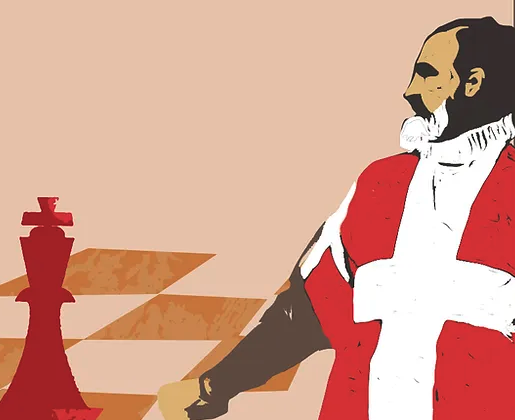The historical tapestry of the Knights Hospitaller is laced with stories of valor, honor, and sacrifice. Founded in the 11th century, this group of celibate monks initially aimed to assist the needy, the infirm, and the Christian soldiers journeying across the Middle East. Soon, they shifted gears, trading their monk robes for battle armors, and transformed into a formidable military force. As time progressed, the Order of Saint John was recognized as an indomitable military unit, resolved to bring the Holy Land under papal control.
One name shines brilliantly in the annals of the Order – Jean Parisot de Valette. Born circa 1495 to the noble La Valette family in Quercy, South West France, de Valette displayed his warrior prowess early on. After joining the Knights Hospitaller in the Langue de Provence, he was entrusted with the defense of Rhodes, the Knights’ headquarters. In 1522, Rhodes faced an intense attack from a 100,000-strong Ottoman army led by Suleiman the Magnificent. De Valette and his team of 700 Knights, alongside 7,000 soldiers, held their ground. After a grueling six-month siege and dwindling resources, they had to surrender, but their valiant resistance earned them Suleiman’s respect.
The Order of Saint John in Malta and de Valette’s Enslavement
Post-Rhodes, the Order found a new home in Malta, offered by the Holy Roman Emperor Charles V, with the condition of guarding the Tripoli outpost and sending an annual falcon to the Viceroy of Sicily. La Valette and his men then began their maritime conquests, hunting Ottoman ships and pirates, cementing their reputation as a formidable naval force. However, fortune took a sharp turn in 1541 when de Valette was captured and enslaved for a year on Dragut Reis’s pirate ship. Upon his release, de Valette sought vengeance, leading him to a string of naval victories. His exceptional leadership catapulted him to the position of Grand Master of the Order in 1557.
During this time, Mediterranean piracy escalated, and Christian forces retaliated, mounting a large-scale assault on Djerba, an Ottoman stronghold, in 1560. Despite the catastrophic loss, the Knights remained relentless. The escalating conflict prompted the Sultan to assemble an army of 40,000 soldiers, aiming to conquer Malta.
The Great Siege of Malta: A Monumental Victory
News of the looming threat reached de Valette, who had an army of merely 500 Knights. Undeterred, he mobilized a militia of 6,000 Maltese peasants, strengthened fortifications, especially around the Grand Harbour, and prepared for the impending onslaught. Despite their efforts, Fort St Elmo fell after a month of intense fighting. Yet, the defenders’ sacrifice allowed valuable time for the relief army from Sicily to assemble.
In response to the Ottomans’ psychological warfare, de Valette, unwavering in his resolve, retaliated equally brutally. He held the Ottomans off, inflicting heavy losses on them. His leadership and strategic tactics resulted in the defeat of the Ottoman forces, marking the end of the Great Siege of Malta.
Valletta: A Legacy of Valor and Defiance
This monumental victory cemented Jean de Valette’s status as one of the greatest Christian commanders. His brave stance during the Great Siege resonated across Europe, instilling renewed hope in the Christian states. Following the victory, he commissioned the construction of Valletta, the new fortified city, a legacy that still stands proudly as Malta’s capital today.
Through his lifetime, Jean Parisot de Valette’s grit, determination, and formidable leadership profoundly shaped the history of the Knights Hospitaller and Malta. His story remains an emblem of the relentless human spirit in the face of overwhelming odds. Today, as we walk the vibrant streets of Valletta, we honor the memory of this brave Knight who once turned the tides of history, reminding us of our past and the battles fought for our present.
Sources:
- Catholic Encyclopedia, Volume 7 Hospitallers of St. John of Jerusalem by Charles Moeller
- Jean Parisot de La Vallette”. South African Relief Organisation of the Order of Malta. Retrieved 23 August 2021
- http://stjohnscocathedral.com/about-the-knights/grand-master-jean-parisot-de-valette-1557-1568.html
- http://www.heritagemalta.org/1565/ottoman-troops-land-in-malta/
- http://www.heritagemalta.org/1565/fort-st-elmo-under-fire-renegade-reveals-ottoman-plan/
- Grant, R.G. (2005). Battle a Visual Journey Through 5000 Years of Combat. London: Dorling Kindersley. p. 133.
- Clodfelter, M. (2017). Warfare and Armed Conflicts: A Statistical Encyclopedia of Casualty and Other Figures, 1492–2015 (4th ed.). McFarland. ISBN 978-0786474707.
- https://www.um.edu.mt/think/1565-was-it-that-great/
- Cassola, A. (1998) The 1565 Ottoman Malta Campaign Register, (Publishers Enterprise Group: Malta, 1998), p. 111.
- Cassar, G. (2005) The role of the Maltese inhabitants during the Great Siege
- Zammit Ciantar, J. (2013), Is it Grand Master Jean De La Valette?r https://timesofmalta.com/articles/view/it-is-grand-master-jean-de-la-valette.469535
- Bonello, G. (2013) De Valette or De la Valette? (https://timesofmalta.com/articles/view/De-Valette-or-De-la-Valette-.453998)


Leave a Reply